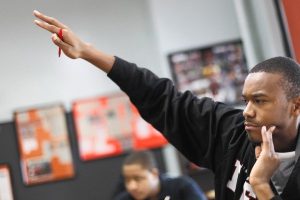
Martez Hampton, 17, is a junior at Leo High School, a Roman Catholic all-boys school on the South Side where all the students graduate. (Chris Walker, Chicago Tribune)
CPS kids would need vouchers to attend ‘unreal’ schoolsAs published by the Chicago Tribune by: John KassSeptember 12, 2012When Chicago Teachers Union President Karen Lewis led her members out on strike this week, she said real school would be closed.
“Negotiations have been intense but productive,” she said. “However, we have failed to reach an agreement that will prevent a labor strike. Real school will not be open (Monday).” Real school? You mean that public system where four of 10 students don’t graduate? Since real school wasn’t open, I was compelled to visit an unreal school. A South Side school where 100 percent of the students graduate, and 100 percent are accepted to college. A Roman Catholic all-boys school that draws from poor and working-class neighborhoods, a school where there are no cops or metal detectors, no gang recruitment, no fear. An unreal school that is mostly black, but with a smattering of whites and Latinos, and where every student who sees a stranger in the halls goes up to the newcomer, introduces himself, shakes his hand, looks him in the eye and calls him Mister. Leo High School, at 79th and Sangamon, seemed pretty unreal to me, too. Leo isn’t pretty. It’s 87 years old. The staircase steps are worn and scalloped from all those years of boys tromping to class. But the minds inside are sure springy, like that of Jeremy Clark, future G-man. “I want to study criminal justice and join the FBI,” said Clark, a junior. “Because I want to be an advocate for justice. It’s been a dream all my life to join the FBI, and I will.” Clark hails from the Roseland neighborhood. He could have gone to a public high school. That, Clark said, would be “totally different. There, it’s every man for himself. At Leo, it’s a brotherhood. We’re all brothers here. You get things done together.” I told him what Lewis said about real school being closed. “So we’re not a real school?” Clark said and laughed. “No, actually it’s totally the opposite. The real schools aren’t closed. The real schools are in session, because we’re trying to learn.” It was my pleasure and honor to meet them, from Sirlaurence King, top student of the freshman class and standout distance runner who wants to become a lawyer, to the senior class’ No. 1 student, James Fagan, a baseball player who will study engineering in college. “I feel bad for the public students who want to learn, and get their education, and graduate,” said Fagan. “I’m glad I didn’t go to public school. I’m focused here. It’s a safe feeling.” At Leo there are 15 students in a classroom. There are only 160 students in all. Tuition is set at $7,500, but that’s just a number. The unofficial motto is that everybody gets something, but nobody gets everything. My friend Dan McGrath, former sports editor of the Tribune, is the school president. “It’s about creating opportunities for these young guys,” said McGrath. “I’ve always felt Leo helped get me off to a good start in life, and those of us who work here are trying to pay it back. Some of our kids might be just another number at a bigger school. At Leo they know they’ll be looked after, they’ll be safe and they’ll get the type of values-based education that will help them become good citizens. We’re not working miracles, we’re educating kids, and doing a good job of it. Leo is a special place. I really believe that.” What if parents had the freedom to take the tax dollars spent on their children at public schools, and choose where to send their kids? Yes, I’m talking vouchers. “If there were vouchers,” said Principal Phil Mesina, “we’d have parents and students lined up all the way down the block. We could accommodate 400. All of our classrooms would be full.” The strike has drawn an unreal amount of national media attention, in part because President Barack Obama is from Chicago and his former White House chief of staff Rahm Emanuel is the mayor. And that has triggered a predictable response: that the system is broken. Unfortunately, the system works just fine. It works for the teachers union that wins the big raises (the current offer: a 16 percent bump over the next four years) and for the bureaucrats who are creatures of patronage, and for the vendors who feed from the almost $6 billion budget. It works for Democratic politicians. They increase property taxes to pay for union raises and, in exchange, receive union support and political donations in election years. It’s been going on that way for years. But does it work for the kids? Not when nearly half don’t graduate. “The Chicago Public Schools system is a monopoly provider of education for the children of the city of Chicago, and the Chicago Teachers Union is a monopoly labor provider, and this is a tragedy for the children,” said John Tillman, CEO of the Illinois Policy Institute. “The only way to create accountability is for CPS to empower parents to have a choice of traditional public school, charter schools or vouchers to private schools. … This is not about breaking the union, it’s about breaking the monopoly control that the union has over children’s lives. I think that’s a key point that no one talks about.” Except maybe at places like Leo, where all boys graduate and are accepted to college, a place where the kids come first. How unreal is that? Twitter @John_Kass
|
Speak Your Mind